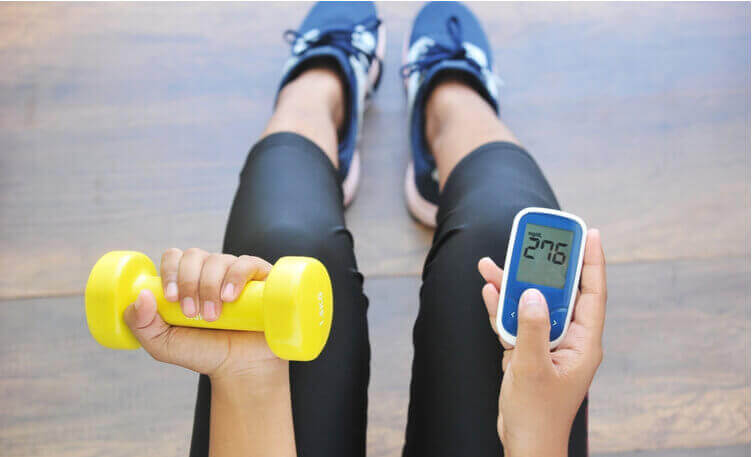Best Exercises For Diabetes

Physical inactivity is one of the major reasons for that contribute to the proliferation of diseases like Type-2 Diabetes (T2DM). Regular exercise can, therefore, offer remarkable benefits for people who have or are at risk of developing Type-2 diabetes.
Can Exercise Help Reverse the Effects of Type-2 Diabetes?

One of the most important ways exercise helps to regulate and reduce blood sugar levels is by making the muscles utilize glucose more efficiently (increased insulin sensitivity). Furthermore, the weight reduction, blood pressure and cholesterol-lowering effects of exercise can further compound the health benefits of exercise. Working out can also help reduce the chances of cardiac disease (a major reason for the loss of quality and quantity of life) in people with Type-2 Diabetes.
How to Design a Diabetes-friendly Exercise Plan
Here are a few things to remember as you begin exercising.
- In the beginning, set realistic and achievable goals and gradually improve on them.
- Always exercise on a light stomach (Can have a light snack before exercise).
- You can gauge the benefit of exercise on your sugar levels by measuring it before and after exercise, and as you step up your exercise program an incremental benefit on sugar control will motivate you more.
- Be well informed about the signs/symptoms of low sugar (especially for those indulging in high-intensity exercises).
- Always have ready access to glucose, to prevent a major low sugar mishap while exercising.
- Elderly patients and those with complications of diabetes must consult their doctor before they start exercising.
- Try to accommodate a minimum of 150 minutes of exercise (moderate to vigorous) into your week, at least 3 days per week and without 2 consecutive days of physical inactivity.
5 Diabetes-Friendly Exercise Tips
We’ve put together a list of exercises you can easily fit into your daily routine. For a more structured exercise program please contact your diabetes specialist.
-
Walking Exercises For Diabetics
Walking is one of the most common, easiest and most effective forms of exercise. It is best done in the open, provided you have a quality track to walk on, the air is clean (indoor exercise is recommended when pollution levels are unhealthy) and the weather is good. Here are some tips to get started.-
Two most important components of walking are duration (time) and intensity (speed). Start at a comfortable speed (that does not tire you at the end) and then work on increasing the duration.
-
Once you reach the maximum possible duration that your schedule allows, gradually increase your speed ‘intensity’. With greater speed, you will burn greater calories at the same time.
-
To maintain motivation use your smartwatch/phone to set daily/weekly goals and make it a point to achieve them.
-
You should never feel tired at the end of a walking session (Tiredness = over-exercise)
-
Each bout of walking should not be less than 10-15 minutes.
-
Aim to get at least 30 minutes to an hour, 3 or 4 times a week.
-
-
Strength (Muscle) Training

This form of exercise is commonly referred to as resistance training. Muscles are a very important organ involved in blood glucose regulation (both in glucose storage and utilization). The role of muscles is now so well studied and recognized, that diabetes management organisations (ADA, WHO, etc.) strongly endorse muscle training as an integral part of all exercise programs (unless contraindicated).
Here are a few tips before you begin a strength training program
- Have at least 2 weekly sessions.
- Have at least one set (10-15 repetitions) of exercise involving 5 or more major muscle groups.
- Start with light weights and work on the number of repetitions first.
- Gradually increase the number of repetitions to your personal preferred number.
- You can start with any - free weights, strap weights or machines, and then slowly increase to heavier weights.
- Stop if you feel pain during the exercise or significant muscle soreness after exercise (contact your doctor/trainer).
- Those with fluctuating sugar levels or uncontrolled blood pressure levels should start only after a doctor's consultation (should also regularly monitor sugar and blood pressure)
- You can perform strength exercise without weightlifting through simple bodyweight exercises like sit-ups, lunges, crunches, squats, and pushups.
-
Hate Exercising? Try Dancing!
If you dislike the monotony of doing the same form of exercise repeatedly, then dancing is a perfect way forward. A dance workout will be a great way to add enthusiasm to your weekly exercise routine. Dancing is a fun way to improve your fitness levels and is an effective stress buster. Dancing not only ensures good metabolic and physical health, but it also gives you superb ‘mental’ and ‘social’ health.
To reap all the benefits of dancing, do it in an organized dance class or you can enjoy it at home with your friends or family. At home, you can use the music you like or use dance lessons/workouts that are easily accessible on the internet. Be careful as some of the dance forms can be very intense. You can follow exercise principles similar to the ones suggested for walking. -
Swimming

If you dislike sweaty t-shirts and smelly socks, just put on your swimwear and dive for health. Swimming is an excellent form of exercise which not only gives you a mixture of aerobic, resistance and flexibility training but also reduces strain on your joints. It provides a full-body workout by engaging almost all the major muscles of the body, at the same time. Additionally, it guarantees superb and superior cardiovascular fitness.
If you are above 30 years of age, with recurrent episodes of low blood sugar/ uncontrolled blood pressure or complications of diabetes, medical advice and clearance of your doctor is a must before starting to swim. Always inform the trainer or lifeguard of your diabetes status before you start to swim. -
Yoga Tips for Diabetics
Yoga is one of the oldest forms of formal exercise. The first descriptions and practices are speculated to date way back to the pre-Vedic times. It's now that the West has recognized its importance. Yoga is now practised globally and it has found its rightful place in the guidelines for diabetes management (ADA). The benefits of yoga have also been scientifically tested and proven.
Yoga is the only form of activity that not only provides health benefits but also helps unify three essential components of existence: ‘mind’, ‘body’ and ‘spirit’. Yoga includes several low-impact exercises that can make you stronger and more flexible. The movement and focus on breathing can ease stress and help build muscle. Proven benefits of practising yoga in people with diabetes include reduction of fasting/PP blood glucose levels, HbA1c (Glycated Hemoglobin) reduction, and better lipid profile, amongst others.






